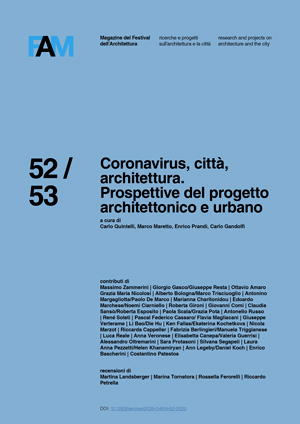Riflessioni sulla progettazione di edifici residenziali e comunità urbane in Cina nell’era post-epidemica
Pubblicato 2020-12-11
Parole chiave
- COVID-19,
- Situazioni doppie,
- Area cuscinetto,
- Comunità resiliente,
- Flessibilità spaziale
Come citare
Abstract
L'epidemia di Covid-19 è un'emergenza sanitaria pubblica di interesse internazionale. Anche se in Cina per controllare l'epidemia sono state adottate numerose misure tempestive ed efficaci, sono emersi comunque problemi e debolezze risalenti alla fase di pianificazione delle città. A livello urbano, dovrebbe essere adottata una progettazione orientata alle persone (people oriented design) nella duplice situazione di normalità ed emergenza epidemica. A livello di comunità, le strutture necessarie, la forma ragionevole, la struttura spaziale ottimizzata possono supportare la costruzione di una comunità resiliente. A livello architettonico, è necessario intervenire sugli edifici residenziali modificandoli per garantire la flessibilità dello spazio abitativo e per rispondere ai cambiamenti della vita quotidiana nell'era post-epidemica.
Riferimenti bibliografici
- DUAN J. (2020) – “Establishing the “Defense Unit” in the Spatial Planning System- Meeting in Response to the 2020 COVID-19 Emergency”. City Planning Review, [e-journal].
- FAN H.Y. e LI T.P. (2020) – “Post-epidemic Community Planning and Goverance under the Theory of Resilient Community”. Urban and Rural Development, 11, 49-51.
- LI X., ZHOU L., JIA T., WU H., ZOU Y.L. e QIN K. (2020) – “Influence of Urban Factors on the COVID-2019 Crisis — A Case Study of Wuhan City”. Geomatics and Information Science of Wuhan University, 45 (06), 826-835.
- PAN L. e ZHAO C.T. (2020) – “Small Bridge Family: The Application of Sinking Road Mode in the Planning of Low-Rise and High-Density Residential Areas”. Architecture Technique, 05, 110-112.
- REN Y.Y. e CHEN C. (2020) – “Thoughts on Prevention and Control of Urban Community Safety and Nesting System of Facilities from the Perspective of Epidemic Situation”. Journal of Human Settlements in West China, 35 (03), 17-22.
- WANG C.R. e WANG C.J. (2020) – “Thoughts on Speeding up the Construction of Intelligent Community Commercial Service System in the Post-COVID-19 Era”. Mercantile Theory, 12, 5-9.
- WU L.F., XU J.W. e LI H.X. (2020) – “Open Block, Controlled Residential Area and Isolated Unit: Construction and Transformation of Three-level Space Prevention and Control System in Urban Settlements”. Planners, 36 (05), 82-84+93.
- YANG J.Y., SHI B.X., SHI Y. e LI Y.H. (2020) – “Construction of A Multi-scale Spatial Epidemic Prevention System in High-density Cities”. City Planning Review, 44 (03), 17-24.
- YUAN Y., HE H.Y. e CHEN Y.J. (2020) – “Research on Urban Green and Blue Space Planning Combining Peacetime with Emergencies”. Journal of Human Settlements in West China, 35 (03), 10-16.
- Cities That Heal: How the Coronavirus Pandemic Could Change Urban Design (2020) –Bostonʼs NPR News Station. [online] Available at:<https://www.wbur.org/onpoint/2020/04/28/coronavirus-pandemic-change-evolution-of-cities-and-urban-design>[last access 23 July 2020] at:<https://mp.weixin.qq.com/s/x4GZDqJdkwTsN2DxCYfj-g>[last access 23 July 2020]

